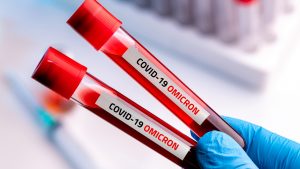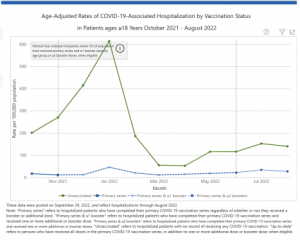-
Omicron’s Infectivity: A Deep Dive into the Enduring Dangers of COVID-19

“Omicron’s Infectivity: A Deep Dive into the Enduring Dangers of COVID-19” written by Dale News Executive Journalist Chris Kosel
The COVID-19 Pandemic has raged on for the better part of two years, changing the way we think and act as a society as we grapple with the crisis. An air of caution now hangs around us as the world heals, with public health mandates continuing to loosen after waves and waves of the virus. Over the past two years, the disease has mutated and morphed multiple times, spawning variants of the original virus with different attributes that affect the infectivity and overall danger of the virus.
Of these variants, Omicron has proven to be its own unique danger in a seemingly never ending sea of turmoil, eclipsing both the original and Delta strains of the virus in terms of recent cases. The infectivity of Omicron has kept the danger of COVID-19 fresh in the minds of the public, and proves that we are not through with the pandemic, and it is not through with us.
To explain the Omicron variant, it is useful to take a step back and look at the larger “family tree” of COVID-19 and its associated viruses and strains. COVID-19 itself belongs to a larger group of coronaviruses, such as Severe Acute Respiratory Syndrome, or SARS for short. SARS itself is a viral respiratory disease caused by a coronavirus, unassociated to the one plaguing the globe currently. SARS is an airborne virus that attacks the respiratory system, possibly inducing high fever, chills, headaches, muscle pain, and mild respiratory symptoms at the onset of illness after incubation, some 2-7 days after initial contact and infection.

COVID-19
According to the World Health Organization, after 3-7 days, “a lower respiratory phase begins with the onset of a dry, non-productive cough or dyspnoea (shortness of breath) that may be accompanied by, or progress to, hypoxemia (low blood oxygen levels)”. In a minority of cases, the respiration affliction is severe enough to require assisted breathing through a mechanical ventilator, not unlike the most dire cases of COVID-19. Since COVID-19 is derived from SARS, they share numerous symptoms including fever, chills, muscle pain, and low blood oxygen content.
The CDC states that the original strain of COVID-19 “is a disease caused by a virus named SARS-CoV-2 and was discovered in December 2019 in Wuhan, China”. SARS-CoV-2 is part of the coronavirus family that causes diseases ranging from head or chest colds to more severe respiratory infections and diseases. The virus is spread through the air via droplets expelled from the mouth and nose whenever someone coughs, sneezes, speaks, or breathes. The name “coronavirus” is derived from the shape of the virus microbe and the spike proteins sticking out of it, giving it a crown-like appearance, with “corona” meaning crown in Spanish.
As COVID-19 entrenched itself in society, we found ways to combat it. Masks and sanitation solutions became commonplace across the globe, and the world raced to develop a vaccine to shield us from this virus. As we researched and developed strategies against COVID-19, it did what any virus would do, and mutated multiple times. Omicron is the latest variant mutation to plague the population.
The Omicron variant of COVID-19 is a mutated strain of the virus originally discovered in December of 2019. It is far more infectious than COVID-19 or the Delta Variant, with Omicron making up an average of 96.18 percent of new cases across the month of January in 2022 according to CDC data. The symptoms of Omicron are similar to those of other variants of COVID-19 including coughing, fever, chills, and muscle pain among others. The fact that Omicron has become the dominant strain in those infected with COVID-19, due to its rapid spread and high infectivity rate, in the three months since its discovery in late November validates the communal concern surrounding it. The latest variant, BA.5, is proving as dominant as Omicron was when initially mutated, making up 83.1% of new cases in the span of June 19th to September 24th of 2022.

Photo: https://covid.cdc.gov/covid-data-tracker/#variant-proportions, accessed 9-29-22
Initial research suggested this was because the viral load of Omicron within an infected person’s body was far greater than that of the Delta Strain or original strain. However, recent studies have shown that the variant has achieved such levels of infection with similar or lower viral levels than those of the Delta Variant, baffling researchers.
Initially, research also indicated that Delta-variant infections contained a higher viral load compared to the original virus earlier in the Pandemic. To compare the viral loads of COVID-19 and its variants, Yonatan Grad, an infectious-disease specialist at the Harvard T.H. Chan School of Public Health, and his co-authors studied PCR tests of nose and throat swabs collected from individuals infected with either the Delta or Omicron variant. They found that the viral load of those infected with the Delta variant either matched or were lesser than the viral load of those infected with Omicron.
Stunned by Grad’s results, Benjamin Meyer, a virologist at the University of Geneva, conducted his own research with his colleagues, measuring not only viral RNA but also the number of infectious virus particles on swabs collected from a separate experimental group of people. Max Kozlov of Nature News iterated that “This more stringent method found no significant difference between the viral loads of vaccinated individuals infected with Omicron and those infected with Delta”, according to the test conducted by Meyer based on Grad’s results.
This showed that viral load was not the cause of the exponential increase in Omicron cases, but was rather a different factor currently specific to Omicron. This variant evades immunity caused by vaccination or past infection with a different strain of the virus. While these studies have yet to be peer reviewed, they provide an insight into the possibilities of why Omicron is as infectious as it is and why it eclipses the Delta variant and original virus in terms of new positive cases.
While COVID-19 immunizations still provide protection from Omicron, data suggests that they are weaker and less effective against this variant, staying in-line with the new research that suggests it evades our immunity against the virus. The data suggests that there was a stark increase in positive cases for the unvaccinated, vaccinated, and boosted alike.

Photo: https://covid.cdc.gov/covid-data-tracker/?itid=lk_inline_enhanced-template#covidnet-hospitalizations-vaccination, accessed 9-29-22
The exponential growth peaked in January of 2022, with over 3,000 positive cases per 100,000 people among the unvaccinated. Similar spikes are mirrored among those who received the initial vaccine and at least one booster, albeit far lower than those unvaccinated. This falls in line with the research suggesting Omicron evades the immunization built up with vaccines and past infections of COVID-19, as well as a continuing pattern that the vaccine’s effectiveness reduces with time.

Photo: https://covid.cdc.gov/covid-data-tracker/?itid=lk_inline_enhanced-template#covidnet-hospitalizations-vaccination, accessed 9-29-22
With Omicron topping infection charts, how does one stay safe amidst the rampage of such a dangerous variant? The available COVID-19 vaccines are the best way to protect oneself and others against the virus. While this variant seems to circumvent some of the immunity the vaccine provides, vaccinated peoples are far less likely to require hospitalization and serious medical care when compared to unvaccinated peoples should the virus be contracted. According to the CDC, the rate of hospitalizations among unvaccinated people is 5.2 times higher than those with the primary vaccine and at least one booster, meaning the vaccine still provides ample protection against the virus.
Basic hygiene, such as washing your hands and using hand sanitizer still help to prevent COVID-19, or other infectious diseases, from spreading via physical contact, and face masks help to prevent the airborne spread of the virus. It is important to keep protection in mind as the world continues to make great strides towards pre-pandemic normalcy.
Work Cited
-
Ahmed, Naema, and Dan Keating. “Coronavirus Vaccine Protection Was Much Weaker against Omicron, Data Shows.” The Washington Post, WP Company, 22 Feb. 2022, https://www.washingtonpost.com/health/interactive/2022/vaccine-omicron-effectiveness/ ?itid=lk_inline_manual_3
-
“Basics of Covid-19.” Centers for Disease Control and Prevention, Centers for Disease Control and Prevention, 2021, https://www.cdc.gov/coronavirus/2019-ncov/your-health/about-covid-19/basics-covid-19. html?CDC_AA_refVal=https%3A%2F%2Fwww.cdc.gov%2Fcoronavirus%2F2019-ncov %2Fcdcresponse%2Fabout-COVID-19.html
-
“CDC Covid Data Tracker.” Centers for Disease Control and Prevention, Centers for Disease Control and Prevention, 2022, https://covid.cdc.gov/covid-data-tracker/?itid=lk_inline_enhanced-template#covidnet-hos pitalizations-vaccination
-
“CDC Covid Data Tracker.” Centers for Disease Control and Prevention, Centers for Disease Control and Prevention, https://covid.cdc.gov/covid-data-tracker/#variant-proportions
-
“Severe Acute Respiratory Syndrome (SARS).” World Health Organization, World Health Organization, https://www.who.int/health-topics/severe-acute-respiratory-syndrome#tab=tab_2
-
Kozlov, Max. “How Does Omicron Spread so Fast? A High Viral Load Isn’t the Answer.” Nature News, Nature Publishing Group, 19 Jan. 2022, https://www.nature.com/articles/d41586-022-00129-z
-
“CDC Covid Data Tracker (Hospitalization and Vaccination Graph).” Centers for Disease Control and Prevention, Centers for Disease Control and Prevention, https://covid.cdc.gov/covid-data-tracker/?itid=lk_inline_enhanced-template#covidnet-hos pitalizations-vaccination (Hospitalization Rate Graph obtained from here)
-
“CDC Covid Data Tracker (Variant Proportions).” Centers for Disease Control and Prevention, Centers for Disease Control and Prevention, https://covid.cdc.gov/covid-data-tracker/#variant-proportions (Variant Percentage table obtained from here)
Thanks for reading! Please check out the information below and have a great day! Feel free to reach out to us at dalenewsfsc@gmail.com

Dale News Online Publication: Oct. 2022
Visit Our New Mobile Link Experience!
@TheDaleNews (withkoji.com)

Believe in The DN
“In Passion We Trust.”
-

